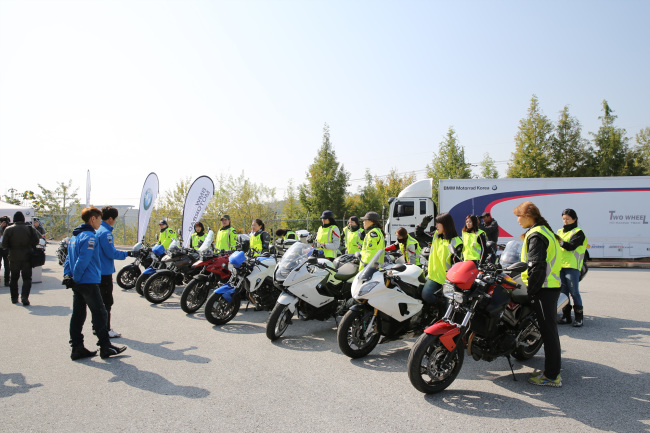[Feature] Middle-aged riders reduce Korea's stigma of motorcycles
Though still small, motorcycle market shows steady growth led by importers
By Kim Bo-gyungPublished : April 29, 2018 - 16:58
Yangpyeong rest area on the outskirts of Seoul bustles with middle-aged male and female bikers amicably conversing with each other as they prepare for the next leg of the ride. It is a scene quite new for South Korea where perceptions toward bikers had been foreign, if not only associated with the young and the restless.
Motorcycles, commonly thought of as a means of transportation for deliverymen in Korea, have mostly been considered a mere nuisance in heavy traffic with their zigzagging maneuvers, increasing exposure to danger and accidents.
But the two-wheelers are gradually getting an image makeover, mainly by men in their 40s affluent enough to afford higher-end motorcycles for leisure. The makeover can be seen as much to their credit, as they wear appropriate safety gear and abide by speed limits.
“Men in their 40s and over with notable social status make up the majority of our customer base. They grew up admiring Western culture shown on TV and in the movies. Now they’ve become financially capable of purchasing and enjoying motorcycles,” Ezra Kim, assistant manager at the marketing division of Harley-Davidson Korea, told The Korea Herald.
Motorcycles, commonly thought of as a means of transportation for deliverymen in Korea, have mostly been considered a mere nuisance in heavy traffic with their zigzagging maneuvers, increasing exposure to danger and accidents.
But the two-wheelers are gradually getting an image makeover, mainly by men in their 40s affluent enough to afford higher-end motorcycles for leisure. The makeover can be seen as much to their credit, as they wear appropriate safety gear and abide by speed limits.
“Men in their 40s and over with notable social status make up the majority of our customer base. They grew up admiring Western culture shown on TV and in the movies. Now they’ve become financially capable of purchasing and enjoying motorcycles,” Ezra Kim, assistant manager at the marketing division of Harley-Davidson Korea, told The Korea Herald.

Buoyed by increasing riders, major importers have seen sales grow.
Leaders in the growing motorcycle market are Honda and Suzuki in the relatively affordable segment, and BMW Motorrad and Harley-Davidson in the luxury range.
US-based traditional cruiser brand Harley-Davidson sold 1,149 units in the first half of last year here, up 3.4 percent on-year. Backed by high brand loyalty, there are some 1,200 members of the Korean chapter of the Harley Owners Group, which boasts around 1 million members worldwide.
“Although Korea isn’t a big market, the rate of Korean Harley-Davidson owners leaving the brand is very low, which reflects strong brand loyalty,” Kim said.
Some customers even purchase a new motorcycle every year to participate in the 16-day journey from Milwaukee to California, an annual event offered exclusively for new Harley bike buyers, according to Kim. Harley-Davidson’s offerings range from 20 million won ($18,700) to 60 million won.
BMW Motorrad and Honda have also reaped record-high sales here on growing demand.
BMW Motorrad flagged its best-ever sales here last year, selling 2,365 units, up 12.4 percent on-year.
Female riders, in particular, have significantly contributed to the change in Korea’s motorcycle market.
“As a kid I had always been envious of riders, but didn’t have the courage to get a license due to social stigma,” said Shin Bo-mi, 28, a beginning rider who started in November 2016.
“Taking control over speed and direction feels liberating and exhilarating,” she told The Korea Herald as she attended the Seoul Motorcycle Show 2018, held earlier in April. Shin owns a Honda PCX scooter and hopes to purchase a race bike one day.
“The steady rise in number of female bikers, boxers, e-sports gamers and such reflect the blurring of boundaries between female and male gender roles in Korea,” said Kwak Geum-joo, a psychology professor at Seoul National University.
The number of licensed female bikers rose to 4,743 in 2015 from 2,429 in 2011, according to data from National Police Agency.
“Female riders make up a small portion of our customers, but they are definitely increasing in number. This is why we held an event exclusively for female customers a few years ago,” said an official of BMW Motorrad.
The company hosted its first BMW Motorrad riding school for entry-level female riders in 2016 in efforts to contribute to creating a safety-first riding culture. This year, it plans to hold similar events in August or September.
The motorcycle market, meanwhile, is notably occupied by foreign manufacturers, be it for leisure or delivery.
Having launched here in 2002, Honda posted record sales last year to rank No. 1 in sales volume. It saw a 9.1 percent on-year hike of 16,625 units, according to the company.
As a relatively affordable brand, Honda’s bikes come in various sizes, mostly purchased for delivery purposes. Small bikes accounted for 92.6 percent, or 15,398 units, of Honda’s sales here in 2017.
“Product quality of local motorcycle brands lag behind foreign brands. Other than Daelim Motor, there are only a few local small motorcycle makers, who mostly produce scooters,” said Seo Yong-gu, a business professor at Sookmyung Women’s University and an avid rider.
By Kim Bo-gyung (lisakim425@heraldcorp.com)








![[Graphic News] More Koreans say they plan long-distance trips this year](http://res.heraldm.com/phpwas/restmb_idxmake.php?idx=644&simg=/content/image/2024/04/17/20240417050828_0.gif&u=)
![[KH Explains] Hyundai's full hybrid edge to pay off amid slow transition to pure EVs](http://res.heraldm.com/phpwas/restmb_idxmake.php?idx=644&simg=/content/image/2024/04/18/20240418050645_0.jpg&u=20240419100350)







![[KH Explains] Hyundai's full hybrid edge to pay off amid slow transition to pure EVs](http://res.heraldm.com/phpwas/restmb_idxmake.php?idx=652&simg=/content/image/2024/04/18/20240418050645_0.jpg&u=20240419100350)

![[Today’s K-pop] Illit drops debut single remix](http://res.heraldm.com/phpwas/restmb_idxmake.php?idx=642&simg=/content/image/2024/04/19/20240419050612_0.jpg&u=)